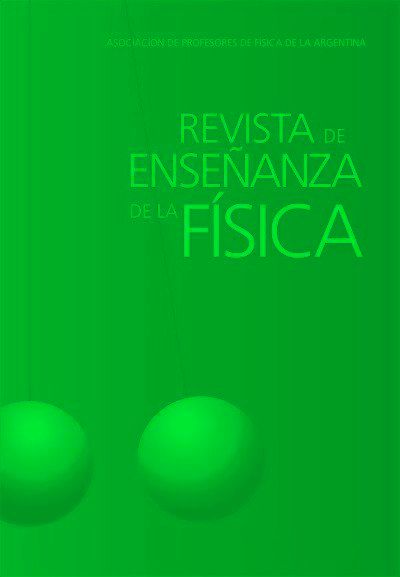The challenges of assessment in the virtual teaching format in an Introductory Physics
DOI:
https://doi.org/10.55767/2451.6007.v33.n2.35310Keywords:
Evaluation, Audiovisual material, VirtualizationAbstract
The challenge of accompanying the students in the non-presence and the adhesion to the formative evaluation made us look for
strategies to review and reorient the evaluation in the subject Introduction to Physics, Physics degree and teacher career, and Mathematics teaching career also. We present a first analysis of the results obtained, both from the point of view of conceptual learning of
the topics covered in the subject, as well as the achievements in the verbalization of the evaluated problems and the analysis of videos.
It also presents the results of an opinion poll on the evaluation system used, as well as on group work in the midterm reviews.
References
Alvarez Méndez, J. (1993). Evaluar para conocer, examinar para excluir. Ed. Morata.
AAPT (1998). American Association of Physics Teachers. Goals of the Introductory Physics Laboratory, American Journal
of Physics, 66, 483-485
Beichner, R. (2006) https://www.compadre.org/per/items/detail.cfm?ID=4404 .
Benegas, J. y Sirur Flores, J. (2014). Effectiveness of Tutorials for Introductory Physics in Argentinean high schools. Physical
Review Special Topics - Physics Education Research 10, 010110.
Benegas, J. y Sirur Flores, J. (2019). Does pedagogy influence gains and losses of conceptual understanding? Revista Mexicana de Física E, 65, 195–199.
Benegas J y Villegas M. (2011) Influencia del texto y del contexto en la Resolución de Problemas de Física. Lat. Am. J. Phys.
Educ., 5, 1, http://www.journal.lapen.org.mx/
Benegas, J. y Villegas, M. (2021). Introducing pre-service math and biology teachers to Physics PCK, Journal of Science
Teacher Education, en prensa.
Bergmann, J. y Sams, A. (2012). Flip Your Classroom: Reach Every Student in Every Class Every Day. New York, NY: International Society for Technology in Education.
Celman Susana (1998): ¿Es posible mejorar la evaluación y transformarla en una herramienta de conocimiento? En Camilloni Alicia, Celman Susasna et al.: La evaluación de los aprendizajes en el debate didáctico contemporáneo Buenos
Aires: Paidós
Freeman, S., Eddy, S. L., Mcdonough, M., Smith, M. K., Okoroafor, N., Jordt, H., y Wenderoth, M. P. (2014). Active learning
increases student performance in science, engineering, and mathematics. Proceedings of the National Academy of Sciences, 111(23), 8410–8415.
Edesltein, Gloria (2011), Formar y formarse en la enseñanza. Buenos Aires: Paidós.
Elliott, John (1990): La investigación-acción en educación. Madrid: Morata
Heller, P. y Heller, K. (1999). Cooperative group problem-solving in physics, University of Minnesota. Recuperado de
https://groups.physics.umn.edu/physed/Research/CGPS/GreenBook.html
Khan Academy (2019) https://es.khanacademy.org/
Mazur, E. (1997), Peer Instruction: A User's Manual. New York: Pearson Educational.
McDermott, L. C. (1991). Millikan Lecture 1990: What we teach and what is learned–Closing the gap. American Journal
of Physics, 59, 301-316. DOI:10.1119/1.16539.
McDermott, L. C., y Redish, E. F. (1999). Resource Letter: PER-1: Physics Education Research. American Journal of Physics,
67, 755. DOI: 10.1119/1.19122.
McDermott, L. C., Shaffer, P. S. and the Physics Education Group (1998) Tutorials in Introductory Physics. New Jersey:
Prentice Hall.
McDermott, L. C. y Shaffer, P. S. (2001). Tutoriales para Física Introductoria, Buenos Aires: Pearson Education.
Meltzer, D. A. y Thornton, R. K. (2012) Resource Letter ALIP–1: Active-Learning Instruction in Physics, Am. J. Phys. 80(6),
478-496.
Perrenoud, Philippe (2008): La evaluación de los alumnos. De la producción de la excelencia a la regulación de los aprendizajes. Entre dos lógicas. Buenos Aires: Colihue.
Polya, G. (1945). How to solve it. Doubleday Anchor Books.
Redish, E. (2003) Teaching Physics with the Physics Suite, N. York, Wiley
Santos Guerra, Miguel (1996): Evaluar es comprender: De la concepción técnica a la dimensión crítica. Revista de Investigación en la escuela.
Sokoloff, D. R. y Thornton, R. K. (2004) Interactive Lecture Demonstrations, Hoboken, New York: Wiley.
VidAnalysis (https://vidanalysis.com/)
Villegas M. y Benegas J. (2020) Aprendizaje Conceptual en un curso de física general basado en estrategias de aprendizaje
activo. Revista de Enseñanza de la Física, 32, 345-354
Villegas M., Rodríguez M. y Benegas J. (2019). Propuesta didáctica para incorporar modelado de movimientos con celular,
Reunión de Educación en Física. https://desarrolloinstitucional.fceia.unr.edu.ar/media/attachments/2019/09/26/libro_de_resumenes_refxxi.pdf
Vygotsky, L. S. (1995/1931). Historia del desarrollo de las funciones psíquicas superiores. Madrid: Visor
Downloads
Published
Issue
Section
License
Copyright (c) 2021 Myriam Villegas Villegas, Adriana Arce Arce, Ana Paula Lucero, Julio Benegas Benegas

This work is licensed under a Creative Commons Attribution-NonCommercial-NoDerivatives 4.0 International License.
Aquellos autores/as que tengan publicaciones con esta revista, aceptan los términos siguientes:Los autores/as conservarán sus derechos de copiar y redistribuir el material, bajo los términos estipulados en la Licencia de reconocimiento, no comercial, sin obras derivadas de Creative Commons que permite a terceros compartir la obra bajo las siguientes condiciones:
- Reconocimiento — Debe reconocer adecuadamente la autoría, proporcionar un enlace a la licencia e indicar si se han realizado cambios. Puede hacerlo de cualquier manera razonable, pero no de una manera que sugiera que tiene el apoyo del licenciador o lo recibe por el uso que hace.
- NoComercial — No puede utilizar el material para una finalidad comercial.
- SinObraDerivada — Si remezcla, transforma o crea a partir del material, no puede difundir el material modificado.
- Los autores/as podrán adoptar otros acuerdos de licencia no exclusiva de distribución de la versión de la obra publicada (p. ej.: depositarla en un archivo telemático institucional o publicarla en un volumen monográfico) siempre que se indique la publicación inicial en esta revista.
- Se permite y recomienda a los autores/as difundir su obra a través de Internet (p. ej.: en archivos telemáticos institucionales o en su página web) antes y durante el proceso de envío, lo cual puede producir intercambios interesantes y aumentar las citas de la obra publicada. (Véase El efecto del acceso abierto).










